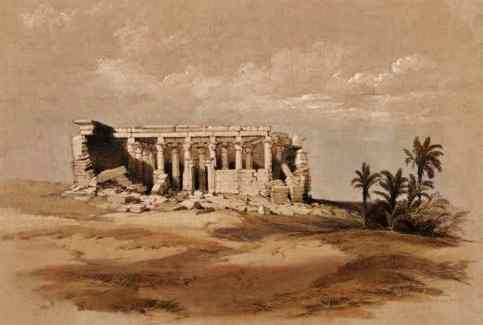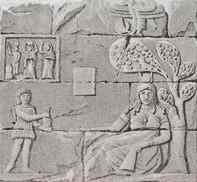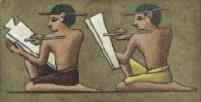AscendingPassage.com
See the: Egyptian Secrets Library.

Wady Meharakka Temple
The temple of Meharrakka (Meharraka, Maharraqa, Maharraka or Maharaga) dates from the Greco-Roman period. It was rescued from the rising waters of the Aswan High dam and placed on higher ground together with Wadi El Seboua temple and the temple of Dakka, for the ease of the tourists.
Wadi Meharrakka and Broken Pots
Edited excerpt from: Travels in Nubia
by John Lewis Burckhardt
Published in 1819.
March 26th, 1813.
In
three hours and a half, we came to El Nowabat, a ruined village
opposite to Thyale on the east bank. The shore
is here very narrow, and the western hills are low and sandy. Eight hours and a
half brought us to the northern extremity of Wady Meharraka (Maharraka), where
the plain widens considerably, being broader than in any other part
north of Derr, though it is cultivated at present only near the
river.

The Temple at Meharraka,
by David Roberts, 1838
Here is the ruin of a temple consisting of a portico of
fourteen massy columns with capitals of different sizes and forms. They are
encompassed by a wall which being joined to the entablature of the
colonnade forms a covered portico all round. The southern wall has
fallen down, apparently from some sudden and violent concussion, as
the stones are lying on the ground in layers, as if they have fallen all at once. I
observed some hieroglyphics sculptured upon single stones lying
about in this part.
The columns on the south side are joined to
each other, except the two center ones, by a low wall half their
height, in the same manner as those in the temple of Philae.
 There is one large entrance, two smaller ones,
and a stair-case leading up to the top. Several paintings of Greek
saints are upon the walls, but no hieroglyphics nor sculptures of
any kind are visible, not even the winged globe. Neither are there any sculptures on the columns.
The walls of this ruin are very neatly and well constructed. There are several inscriptions in the ancient popular
Egyptian script, such as is seen on manuscripts of
papyrus.
There is one large entrance, two smaller ones,
and a stair-case leading up to the top. Several paintings of Greek
saints are upon the walls, but no hieroglyphics nor sculptures of
any kind are visible, not even the winged globe. Neither are there any sculptures on the columns.
The walls of this ruin are very neatly and well constructed. There are several inscriptions in the ancient popular
Egyptian script, such as is seen on manuscripts of
papyrus.
The whole portico stands upon a terrace of massy stones up to eight
feet high towards the river. On this side is the great gate, but,
as there are no steps up to it, it is probable that it was used
only during the inundation, when vessels might moor close
under it. At present, the water does not reach the temple at the
time of the inundation. The portico is fifteen paces in length, and
nine in width. There is nothing about it which denotes it to be
of Egyptian origin, except the palm-leaves sculptured on the
capitals of the columns. It possesses an imposing
simplicity, and belongs, I think, to the last epoch of Egyptian
architecture.

The Temple at Wadi Meharraka,
by François Chrétien Gau, 1819
Close to the walls of the portico are the remains of
another building, which had probably been a temple similar to the
above, and not a part of the same structure. I could not
perceive any corresponding parts in the two
buildings. A wall and the foundations of the
principal building only remain. On the wall are several sculptures, one of
which represents a goddess sitting under a tree, and receiving
offerings. It is in high relief, unlike any thing of the kind I
have seen in Egyptian temples, and more resembling Grecian
sculpture.

From the Temple of Wadi Meharraka,
by François Chrétien Gau, 1819

Photograph by Francis Frith 1862.
This circumstance, and the Grecian-like simplicity of
the portico, lead me to conjecture that both edifices were the work
of the Ptolemies, who constructed temples to the Egyptian deities
in several parts of Egypt. I saw no hieroglyphics on the
walls.
There are large mounds of rubbish and fragments of pottery in
this place.
Near Wady Meharraka the island of Derar commences. At eight
hours and three quarters is the village of Korty.

by Hector Horeau 1841.
Wady Korty Temple
About two hundred
yards from the river stands a ruined temple. It is the smallest I
have seen, and may truly be called an Egyptian temple in miniature. It is only ten paces in length. The cella and adytum are yet
standing, the pronaos seems to be buried under the sand. Of the
sculptures, a few figures and the winged globe over the gates
remain, but the whole temple is in a very mutilated state.
NEXT CHAPTER
Edited excerpt from: Travels in Nubia
by John Lewis Burckhardt
Published in 1819.

Countless beautiful 19th century images of ancient Egypt
and 75 pages of architecture, art and mystery
are linked from the library page:

The Egyptian Secrets Library




 There is one large entrance, two smaller ones,
and a stair-case leading up to the top. Several paintings of Greek
saints are upon the walls, but no hieroglyphics nor sculptures of
any kind are visible, not even the winged globe. Neither are there any sculptures on the columns.
The walls of this ruin are very neatly and well constructed. There are several inscriptions in the ancient popular
Egyptian script, such as is seen on manuscripts of
papyrus.
There is one large entrance, two smaller ones,
and a stair-case leading up to the top. Several paintings of Greek
saints are upon the walls, but no hieroglyphics nor sculptures of
any kind are visible, not even the winged globe. Neither are there any sculptures on the columns.
The walls of this ruin are very neatly and well constructed. There are several inscriptions in the ancient popular
Egyptian script, such as is seen on manuscripts of
papyrus.





